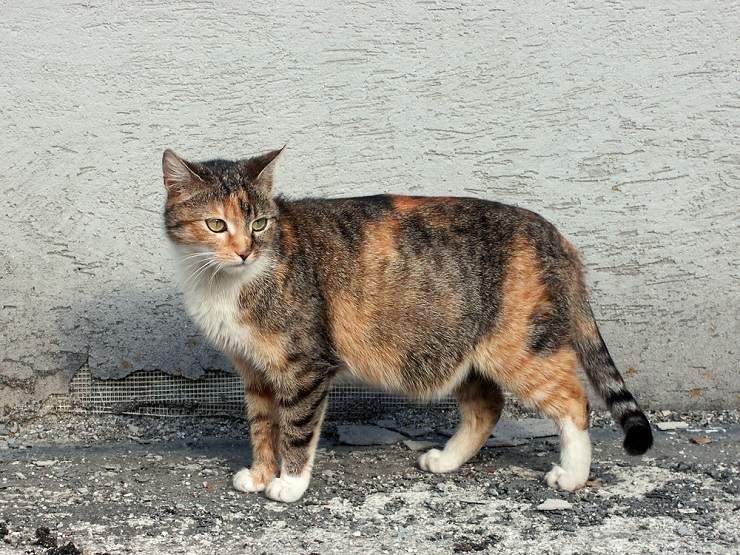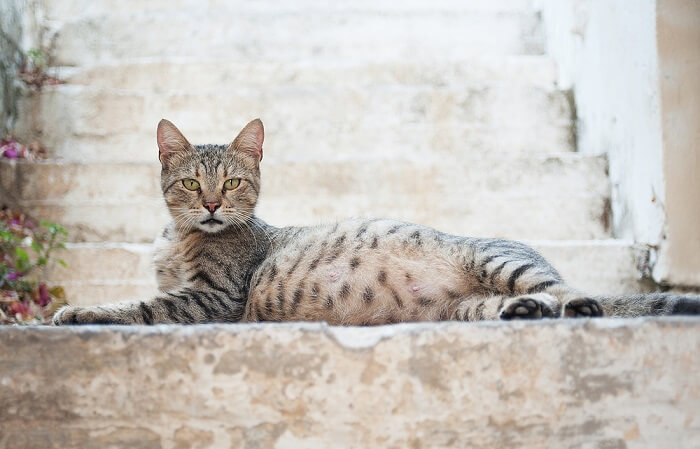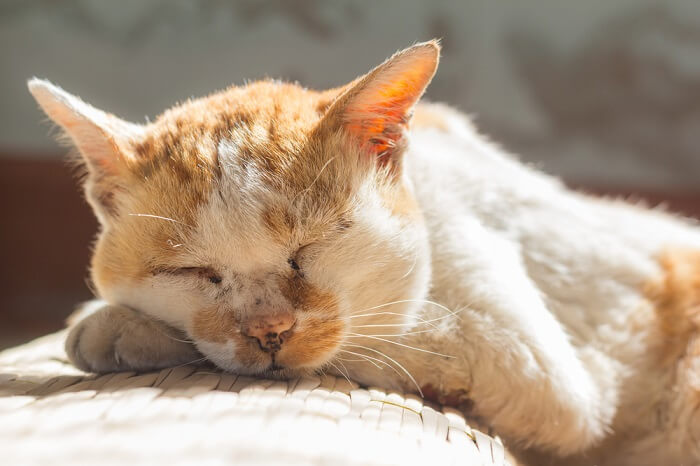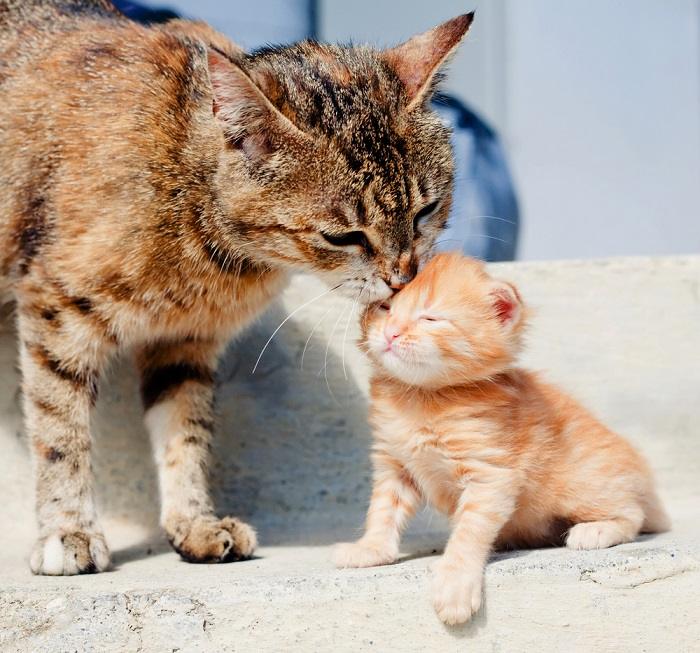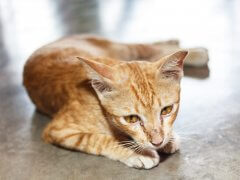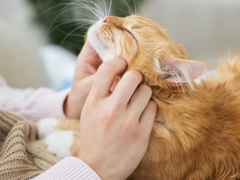This article aims to explain the details of pyometra in female cats, a common and serious infection of the uterus which can be a life threatening condition. The aim of this article is to provide a simple, clear explanation about pyometra for cat owners.
Quick Overview: Cat Uterus Infection (Pyometra)
What Is Pyometra?
The word “pyometra” is derived from the Greek for pus or infection (pyo) and uterus (metra), so it means “uterine infection” or “pus or infection in the womb” or “infected uterus”.
At a more detailed level, the condition involves gross enlargement of the uterus, with cystic enlargement of the glands in the uterine lining. A pus-like liquid gathers inside this diseased uterus.
The first stage of the disease process is Cystic Endometrial Hyperplasia (CEH), which describes the early changes in the uterine wall, making it less effective at dealing with the normal bacterial infections that challenge the uterus. When the cervix is open during the estrus stage of the heat cycle, bacteria can enter the uterus.
A healthy uterus is able to deal effectively with this infection, while CEH leads to a less effective response and pyometra then develops over a period of time.
How Common Is Pyometra?
Pyometra is less common in cats compared to dogs. It’s said to occur in around 20% of unspayed female dogs, and while estimates of its prevalence in cats varies, it may affect around 3 – 5% of unspayed female cats.
The average age of diagnosis is around five to seven years of age, and the condition becomes more common as intact female cats grow older.
It’s more common in some pedigree breeds of cat, including Sphynx, Siberian cat, Ocicat, Korat, Siamese, Ragdoll, Maine coon, and Bengal.
Obviously, spayed cats cannot develop pyometra if the uterus has been removed (as is usually the case during the spay operation). The exception to this is so-called “stump pyometra” – see below for more details.
Stump Pyometra
Occasionally, after a cat has been spayed, a remnant of ovarian and uterine tissue may be left behind, and this can allow the development of a condition called “stump pyometra”, where the remnant of uterine tissue develops pyometra.
Diagnosis, treatment and prognosis of this condition are the same as for regular pyometra. The only complicating factor is that the diagnosis may not be at the top of the list, as the assumption may be that a spayed cat should not be vulnerable to pyometra.
How Do Cats Get Pyometra?
Pyometra is caused by initial changes in the structure of the wall of the uterus, with cysts developing (Cystic Endometrial Hyperplasia or CEM) linked to high progesterone levels in the blood stream and aging.
Then when the cervix is open during the estrus stage of the heat cycle, when there are high levels of estrogen, bacteria can enter the uterus. A normal healthy uterus is able to deal effectively with this infection, but a uterus affected by CEH has a less effective response.
As the bacteria multiply, the immune system responds by producing large numbers of a type of white blood cell called neutrophils.
This combination of bacteria and neutrophils creates the foul-smelling liquid called pus which accumulates inside the uterus, and this is seen as a defining feature of this condition.
Clinical signs are usually seen within 4 weeks of the onset of estrus, partly because the cervix is open during estrus allowing bacterial infection of the womb at that time, plus partly because the progesterone surge after estrus means that the immune system is less effective at clearing out infection at that time.
Symptoms of Pyometra in Cats
Signs of pyometra typically include:
- Polydipsia (Excessive Drinking)
- Polyuria (Excessive Urination)
- Pyrexia (High Temperature)
- Dullness
- Anorexia Or Inappetence
- Weight Loss
- Purulent Or Bloody Vaginal Discharge
- Distended Abdomen
- Painful Abdomen
- An Enlarged Uterus
- Vomiting
Affected cats often develop systemic sepsis, leading to dehydration , weakness, collapse, tachypnea, tachycardia, pale mucous membranes and cardiac arrhythmias.
There are two broad types of pyometra, depending on whether the cervix (the tube between the vagina and the uterus) is open or closed.
- A closed pyometra (or closed cervix pyometra) develops when there is a closed cervix, and so the purulent contents of the uterus cannot be discharged. This is more difficult to diagnose (there is no vulval discharge) and is potentially more dangerous, as the toxic contents of the uterus cannot be released, leading to more toxins being absorbed into the blood stream. There is also an increased risk of uterine rupture.
- An open pyometra (or open cervix pyometra) occurs when there is an open cervix, and the purulent contents of the uterus can then drain to the outside world; a purulent discharge is seen at the vulva, making this condition easier to diagnose. Additionally, the fact that the pus is draining means that less toxins accumulate in the uterus, and less toxins are absorbed into the system, so cats may be less seriously ill.
Causes of Pyometra in Cats
Your veterinarian may recommend specific blood tests for some viral infections such as FeLV and FIV, since there are significant implications if your cat is positive for either of these.
This is primarily a disease of older cats: the most common cause is age, breed and hormone related degeneration of the wall of the uterus, leading to cystic endometrial hyperplasia. This reduces the ability of the uterus to cope with bacterial infection, leading to the accumulation of pus.
Diagnosis of Pyometra
If your DVM veterinarian suspects that your cat may have pyometra, the following steps may be taken.
1. Detailed History Taking
Your vet will discuss every aspect of your cat’s condition and overall cat health. There are other causes of the same types of signs as pyometra, and this history will help to differentiate the various possible causes.
2. Physical Examination
Your veterinarian will check your cat over carefully, checking for the signs of pyometra listed above. Your vet will also carry out auscultation of your cat’s chest (listening with a stethoscope), listening to the lungs as well as assessing your cat’s heart rate and sounds.
They will carry about palpation of the abdominal cavity, feeling for pain and swelling, and specifically checking for the possibility of an enlarged uterus.
3. Routine Blood Tests
It’s very likely that your veterinarian may carry out routine blood work, including the usual panel of diagnostic tests, such as hematology (blood count) and biochemistry profiles. Typically, a raised white blood cell count (leucocytosis) may be seen with a so-called “shift to the left” (neutrophilia), although in rare cases this could be normal, or even reduced (leucopenia).
4. Specialised Blood Tests
Your veterinarian may recommend specific blood tests for some viral infections such as FeLV and FIV, since there are significant implications if your cat is positive for either of these.
5. Other Tests
- Radiographs (x-rays) may be taken: an enlarged uterus is often visible.
- Ultrasound may be recommended, as an even more sensitive way of visualising the uterus, and this can also be a useful way to check for complications such as peritonitis.
- Urinalysis may be recommended to check for blood, protein and glucose in the urine.
- Vaginal cytology may be recommended.
Your veterinarian will advise you on which detailed investigations are needed.
Treatment for Pyometra
- The primary treatment is the surgical removal of the ovaries and uterus (ovariohysterectomy or OHE, also known as spaying or neutering).
- Intravenous fluid therapy (iv fluids) is usually given, as dehydration is a common feature of pyometra, and this aggravates the illness by reducing the clearance of toxins from the circulation.
- Antibiotic cover is essential, as both localised bacterial infection and generalised sepsis are often seen in pyometra.
- Pain relief is an important part of care
- Affected cats usually need to be kept under intensive care for 48 to 72 hours after surgery.
Medical Treatment
In young, breeding animals that are not seriously unwell, it may be possible to take a medical approach, using prostaglandins to empty the pus-filled uterus. This approach should be discussed in detail with your veterinarian, as significant side effects of the medication may be experienced.
Monitoring and Prognosis
- The success rate of surgery is very high at 92 – 95%.
- The main risk is rupture of the uterus, which decreases the survival rate to 50% when it happens.
- Complications may be seen in around 20% of cases including urinary tract infections, thromboembolic disease, sepsis, and wound infections.
- The success rate of a medical approach in appropriately selected cases is over 90%.
Conclusion
Pyometra is a serious disease of the uterus that can affect unspayed female cats. Prompt veterinary care is important if a cat does develop pyometra. The condition can be completely prevented by spaying, which is one of the reasons for the strong recommendation in favor of routine spaying for all cats not intended for breeding.
Frequently Asked Questions
How do you treat an infected uterus in a cat?
Intensive care from your veterinarian is needed to stabalise your cat, and then surgical removal of the uterus (spaying) is the most effective long term treatment.
What are the first signs of pyometra?
A wide range of signs can be seen, but the classic sign to look out for is a purulent discharge from the vulva.
How do I know if my cat has pyometra?
Signs to look out for include polydipsia (excessive drinking), polyuria (excessive urination), pyrexia (high temperature), dullness, anorexia or inappetence, purulent or bloody vaginal discharge, swollen abdomen, painful abdomen, an enlarged uterus and vomiting. If these signs happen in the weeks after your cat has been in season, pyometra is high on the list of possible causes.
Is pyometra painful in cats?
Pyometra does not always involve a painful abdomen, but this is sometimes seen.
How much does it cost to treat a cat with pyometra?
It is impossible to estimate this cost, as there are so many possible factors going on in the background of individual cases. You should ask your veterinarian for a detailed estimate before agreeing to proceed with treatment. Costs could vary from $1000 for a simple case to $6000 or more for an exceptionally complex case of pyometra.
What can cause pyometra in cats?
Pyometra in cats is caused by changes in the uterine wall, caused by age and hormonal influences, as well as being affected by genetic factors (certain breeds area more common).
Can a cat survive pyometra?
Over 90% of cats recover from pyometra when comprehensive treatment is given, but this is a serious disease, and without treatment, the mortality rate is very high.
Is cat pyometra contagious to other cats?
Pyometra is not infectious, so it is not contagious to other cats.
How serious is pyometra in cats?
This is a very serious and life threatening disease, requiring urgent and comprehensive veterinary treatment.
Can pyometra be prevented
Spaying of young cats is the best way to prevent pyometra: this is one of the reasons why spaying is recommended as a routine part of a wellness program for cats.
